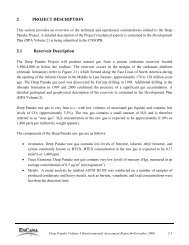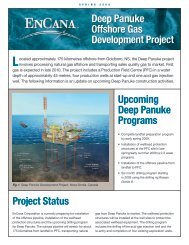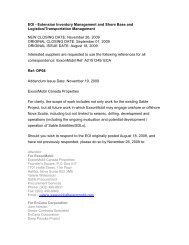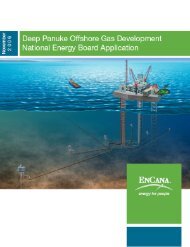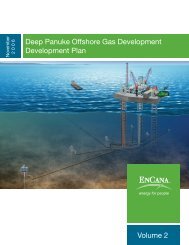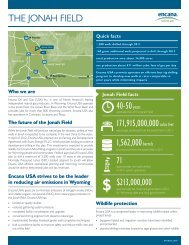Deep Panuke Project Newsletter - Encana
Deep Panuke Project Newsletter - Encana
Deep Panuke Project Newsletter - Encana
Create successful ePaper yourself
Turn your PDF publications into a flip-book with our unique Google optimized e-Paper software.
D E E P P A N U K E P R O J E C T N E W S L E T T E R<br />
E N C A N A A N D T H E E N V I R O N M E N T<br />
Digging for Energy in Action<br />
PHOTO: DAVE NICHOLS, PRISMA PRODUCTIONS<br />
PHOTOS: DAVE NICHOLS, PRISMA PRODUCTIONS<br />
EnCana’s <strong>Deep</strong> <strong>Panuke</strong> team discovered a different type of energy recently at<br />
a Halifax elementary school.<br />
EnCana and other offshore oil and gas industry representatives joined<br />
hands with grade 4 and 5 students at LeMarchant St. Thomas School to participate<br />
in Energy in Action, an educational program aimed at teaching students about where<br />
different types of energy come from, what their impacts are, as well as ways we can<br />
all conserve energy. The students and volunteers then worked together to create an<br />
environmental legacy from the event.<br />
The educational component of Energy in Action was delivered by staff of the<br />
Discovery Centre, Nova Scotia’s hands-on science centre. The lesson included<br />
discussions on renewable and non-renewable energy sources, as well as examples<br />
of various products that are made from petroleum. Following a lunch break, students<br />
and industry employees then worked together to plant trees, shrubs and flowers<br />
on the school grounds. Services for the afternoon planting activity were provided by<br />
Springvale Nurseries, who matched donations of participating companies by<br />
providing labour and materials.<br />
Since 2004, 52 companies and more than 1,300 oil and gas company<br />
volunteers have participated in Energy in Action events in 44 communities across<br />
Canada. Eighteen events were held in 2008, from the Fort St. John region in<br />
You’ve Got<br />
Questions.<br />
<strong>Deep</strong> <strong>Panuke</strong><br />
Experts Can<br />
Answer.<br />
The EnCana team welcomed about 75<br />
A. visitors to the four-hour long open house,<br />
fi elding questions about safety, environmental<br />
effects, local employment opportunities, community<br />
investment, construction and operations.<br />
Local residents wanted to learn what has been<br />
done to date to develop <strong>Deep</strong> <strong>Panuke</strong>, what will<br />
be done in the months ahead and how EnCana’s<br />
presence will affect the community.<br />
The 12 story boards on display outlined<br />
the project timeline for <strong>Deep</strong> <strong>Panuke</strong>, described<br />
upcoming construction stages of the project and<br />
provided information about the National Energy<br />
Board process for the detailed pipeline route.<br />
Other boards shared background on the<br />
project’s environmental commitments and<br />
specifi c mitigation being put in place for the<br />
construction program planned for this Fall.<br />
In addition to the story boards, three<br />
banners depicted the pipe coating process taking<br />
place at Sheet Harbour, NS. A computer monitor<br />
station showed two videos: the fi rst, a “walk”<br />
through the Production Field Centre at <strong>Deep</strong><br />
<strong>Panuke</strong> and the second, a video of the vessels<br />
and equipment that will be used to install the<br />
offshore <strong>Deep</strong> <strong>Panuke</strong> pipeline.<br />
EnCana would like to thank the visitors<br />
to the open house for their interest in the <strong>Deep</strong><br />
<strong>Panuke</strong> project and for the warm welcome to<br />
the community.<br />
Have a question Email dpinfo@encana.com<br />
Donna Morykot<br />
Regulatory Advisor<br />
Q.I could not attend EnCana’s open house<br />
in Isaacs Harbour on September 17.<br />
Can you tell me what happened<br />
Rob MacQueen discusses the <strong>Deep</strong><br />
<strong>Panuke</strong> project with Lesley Carruthers.<br />
Gordon MacDonald (left) and Alvin<br />
Alleyne at the September 17 open<br />
house. The metal circle on the table<br />
is a cross section of the <strong>Deep</strong> <strong>Panuke</strong><br />
export pipeline.<br />
Marielle Thillet (back) and Kent<br />
Gustavson (right) review a<br />
<strong>Deep</strong> <strong>Panuke</strong> story board with<br />
Stephanie More.<br />
British Columbia to St. John’s, Newfoundland. To learn more about Energy<br />
in Action, visit www.capp.ca<br />
Tracy Wright of the <strong>Deep</strong> <strong>Panuke</strong> team digs in with students at LeMarchant St. Thomas<br />
School in Halifax.<br />
<strong>Deep</strong> <strong>Panuke</strong> Production Field Centre<br />
New Illustration<br />
This just in – a September 2008 illustration of the<br />
<strong>Deep</strong> <strong>Panuke</strong> Production Field Centre (PFC). In this<br />
view, you are “standing” north of the PFC and looking<br />
toward the south.<br />
Single Buoy Moorings Inc. (SBM) will own and operate the PFC and<br />
will lease it to EnCana for the life of the project. The PFC will stand in<br />
approximately 45 metres of water and will be affixed to the sea bed<br />
for the life of the field.<br />
The illustration below is taken from a three dimensional model<br />
rendering of the PFC.<br />
Total elevated weight supported on the four legs is circa 13,500 tonnes.<br />
A jacking system will raise the PFC to its permanent position approximately<br />
23 metres above the surface of the ocean. The jacking system for the PFC is<br />
made up of four jacking units – one per leg – located in the red jackhouses<br />
at each corner of the PFC. The jacking units have a jacking capacity of 5500<br />
tonnes each.<br />
Note the turbine/generator exhaust stacks (light blue colour) on the four<br />
power generators at the back of the illustration. Each power generator is<br />
approximately 13 megawatts. The flare tower is the red and white structure<br />
to the left of the illustration. Each side of the PFC has a crane; the base of<br />
each crane is the large yellow vertical structure as noted.<br />
Natural gas will flow from four production wells to the PFC. From the<br />
PFC, the gas will be transported via the <strong>Deep</strong> <strong>Panuke</strong> export pipeline to<br />
landfall at Goldboro, NS, an approximate distance of 173 kilometres.<br />
Near landfall, the <strong>Deep</strong> <strong>Panuke</strong> export pipeline will hook into the<br />
Maritimes & Northeast Pipeline system for transportation of the natural gas<br />
from the field to market.<br />
FLARE TOWER<br />
CRANE PEDESTAL<br />
TURBINE/GENERATOR<br />
EXHAUST STACKS<br />
JACKHOUSE<br />
The PFC will be anchored to the sea bed with giant spud cans, circular structures at the<br />
bottom of each leg that measure 17.5 metres in diameter and penetrate the sea bed<br />
three metres.<br />
PHOTO: DAVE NICHOLS, PRISMA PRODUCTIONS ILLUSTRATIONS: SBM<br />
F A L L 2 0 0 8



